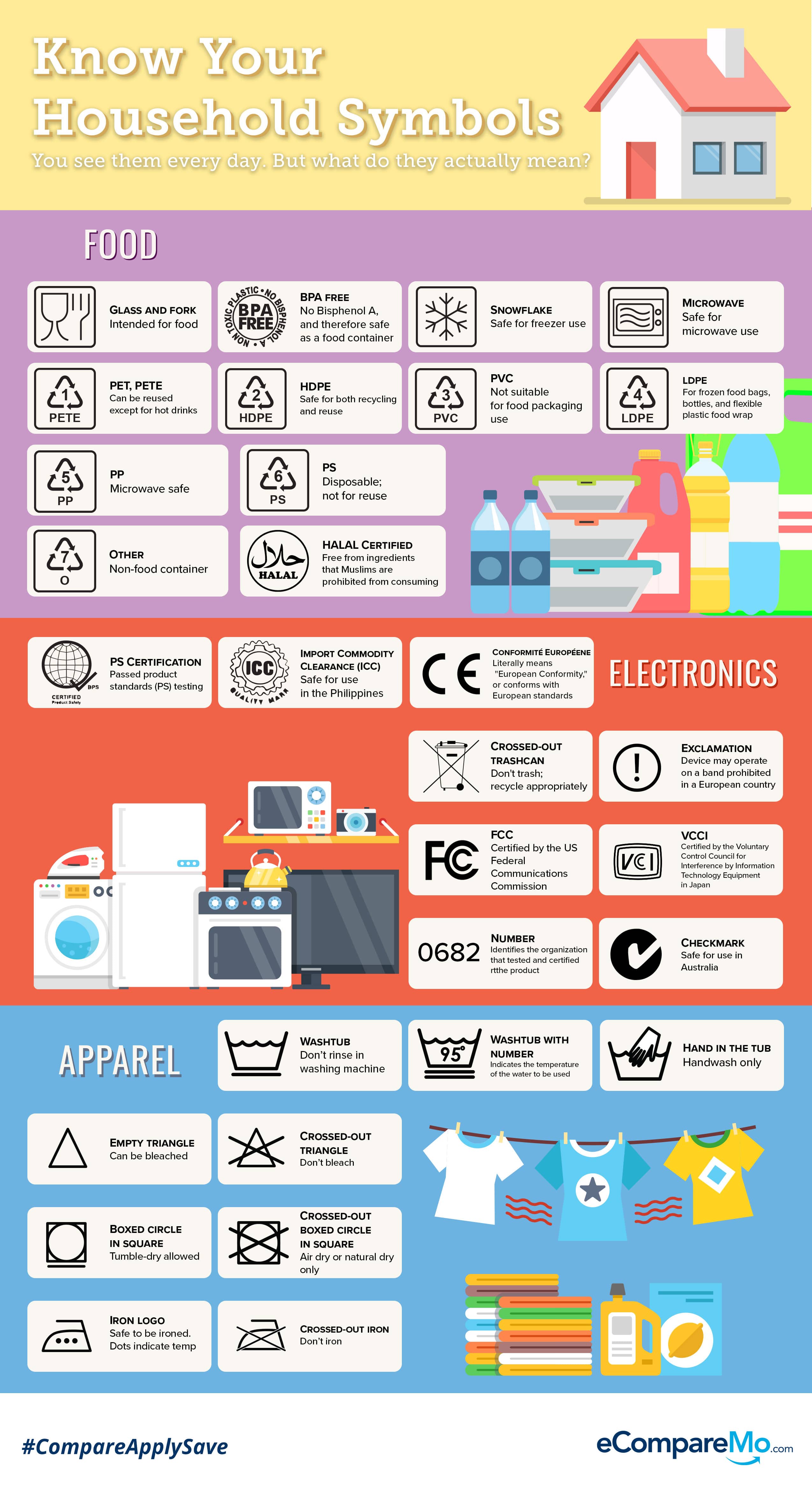How Many Of These Symbols On Household Items Do You Really Understand?
4 min readThere’s a reason a certain milk brand recommends that you always “check the labelâ€â€”it’s there to tell you how to use different products correctly. However, not everyone is a big fan of symbols, more so interpreting them.
The small icons on household products you use every day? They all provide crucial information for safety and proper usage. Sadly, they don’t come with explanations nor instructions. So here they are, decoded for your guidance. Think of this infographic as your cheat sheet for avoiding health hazards and unnecessary expenses.

Food
Not all food containers are equal; while some are good for long-term use, others are only usable for a meal or two. Be sure to read the bottom of your Tupperware or Lock & Lock before you store your lunch for the day.
Glass and fork icon. Adopted by plastic manufacturers all around the world, this symbol indicates that the product uses materials specifically made for food containment, and will not contaminate its contents.
BPA free. Bisphenol A, an industrial chemical used to make some plastic and resin products since the ’60s, has long been banned for use in container products because of its long-term effects on the human body. Products with the BPA-free label are therefore safe for use as food containers.
Halal-certified. Food suitable for consumption for Muslims, according to the Islamic Sharia Law. Forbidden food includes: blood, alcohol, meat from pigs, carnivorous animals
Snowflake icon. Not every food receptacle is made to withstand below-zero temperature. If the container has a snowflake logo somewhere, then it’s safe for freezer use.
Microwave icon. Items with this logo can be used to heat or defrost food using microwave ovens. If you use a plastic container with the microwave logo, it may melt and contaminate your food.
Mobius strip with numbers. The Mobius strip with three arrows is a universal logo for recyclable materials. To identify which material is used to make the plastic, check the following numbers:
1 – PET, PETE (polyethylene terephthalate). Mostly used on beverage bottles, they can be reused indefinitely except for hot drinks.
2 – HDPE (high-density polyethylene). Used on water pipe, beverage bottles, grocery bags, and toiletry bottles.
3 – PVC (polyvinyl chloride). Used to make pipes, cables, furniture, and toys but not suitable for food packaging.
4 – LDPE (low-density polyethylene). Plastic material for frozen food bags, squeezable bottles, plastic food wrap, and other flexible food containers.
5 – PP (polypropylene). Plastic used on microwavable products, containers made from PP can withstand heat without deforming or contaminating food.
6 – PS (polystyrene). A material designed for disposable food containers like egg trays and plastic cutlery, these are neither ideal for long-term food storage nor for reuse.
7 – Other (often polycarbonate or ABS). while the application is mostly on non-food containers, feeding bottles are made of these resins.
TIP: Safety experts recommend plastics with labels 1, 2, 4 as safe food containers.
Electronics
Faulty electrical connections are the leading cause of fires in the Philippines. According to the Bureau of Fire Protection, “Electronic connections are consistently at the top of the list,†followed by open flames and cigarette butts.
To protect your home from fire accidents, be sure to look for the following symbols on appliances before purchase.
PS Certification mark. To make sure that locally made electronics meet international standards, the Department of Trade and Industry’s (DTI) Bureau of Product Standards (BPS) puts the Philippine Standard (PS) Certification Mark on all appliances that pass their rigorous testing.
ICC mark. To make sure the products will be safe for Filipino consumption, the DTI puts Import Commodity Clearance (ICC) stickers on electronic items that pass their standards.
QC passed. Usually a sticker that indicates the item has passed quality control standards in the country.
CE symbol. Often seen on smartphones. It’s an abbreviation of French phrase “Conformité Européene,” or “European Conformity.”
Crossed-out trashcan icon. This means recycle appropriately, and do not throw in the trash bin.
Exclamation. This is a warning that the device may operate on a band prohibited in a European country.
FCC. Also common in iPhones and other tech, it means the device is certified by the US Federal Communications Commission, the counterpart of the National Telecommunications Commission (NTC) in the Philippines.
VCCI. Similarly, it means it’s certified by the Voluntary Control Council for Interference by Information Technology Equipment in Japan.
“Random” number. Not really random–it serves as the identification number of the organization that independently tested and certified the product.
Apparel
Your clothes can last longer if you know how to take care of them. Since clothing articles are made of different materials, it’s hard to have a single universal care on how to make sure they’re kept in their optimum condition. Fortunately, manufacturers use universal logos to remind you on how to take care of your precious clothes—and make sure they last for a very long time.
Washtub icon. The stylized washtub logo is a universal symbol that the item can be rinsed with a washing machine. If the tub has a number inside, it indicates the maximum temperature of the water to be used. Meanwhile, a hand in the tub signifies that it’s strictly for handwash only.
Triangle symbol. An empty triangle logo means that the apparel can be bleached. In contrast, bleaching is prohibited when the article has a crossed-out triangle.
Circle inside square symbol. Symbolizing the dry cleaner, a boxed circle means that the item can be tumble-dried. A crossed-out logo means that only natural drying such as hanging on the clothesline is recommended.
Iron icon. An ironing symbol means that the item can be ironed to remove the wrinkles of the cloth. Meanwhile, a crossed-out iron logo means that ironing is not allowed.
